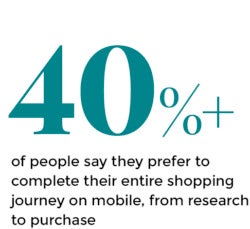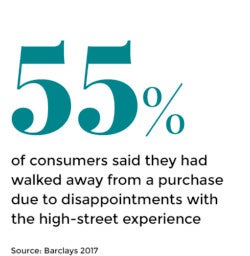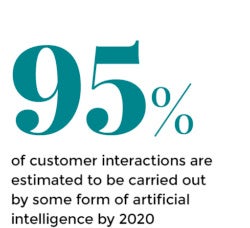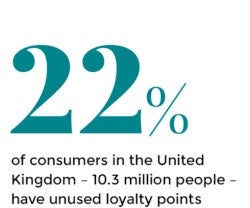Despite its maturity, there are still many failures in customer service in 2018. Why are these still occurring and what are the best future-proof solutions?
To find out, Raconteur asked dozens of C-suite executives and senior business leaders. Here, in their own words, is what they said:
01 - It’s all about being personal
If customer service isn’t personal, and you don’t know your customer, then it isn’t working. Transforming the retail experience to connect the high street with the online realm requires fundamental changes in the retail business model. To achieve retail nirvana, businesses must integrate and augment personalised customer service throughout, covering all touch points from the store, to online, to mobile. Few have recognised the technology that already exists to help them survive and prosper in the digital age. Retailers lack the integrated vision and execution plan to address these new imperatives. Shane Finlay, chief value advisor, SAP
02 - The need for speed

Over 40 per cent of people say they prefer to complete their entire shopping journey on mobile, from research to purchase. However, many companies let themselves down with slow loading times.
Over half (53 per cent) of us give up if a site takes longer than three seconds to load, but the average UK mobile site load speed is 8.9 seconds. It’s clear that the average experience on mobile is too slow for today’s customers, who need answers and actions quickly. These common frustrations get in the way of excellent customer service. Alessandra Alari, head of search (large customer sales), Google UK
03 - Use data to create an experience
We are now in an experience-driven world; we have to make experiences out of business. The customer journey needs to be powered by unique identification and data. To understand the customer you need intelligence, and to access the right data at the right time. Vijayanta Gupta, head of product and industry marketing, Adobe Systems Europe
Data has to be seen as a game-changing asset. Therefore business leaders need to become experts in data science and artificial intelligence. That drives a completely different way of thinking, and behavioural change is required. CEOs who are not interested in data will not keep their positions for very long. Andy Day, chief data officer, Sainsbury’s
04 - Be consistent across channels
The biggest customer service risk, and therefore opportunity, is the blurring of channels; consumers don’t differentiate between .com and in-store, mobile and desktop, or sales associate and online chatbot. Nor should brands. Ensuring customer service is consistent across the channels and reducing unnecessary friction between consumer touchpoints is the number-one priority for business – getting this right will exponentially multiply the brand experience. Getting it wrong will just erode customer trust and loyalty. Will Glynn-Jones, managing director, M&C Saatchi Shop
05 - Make it easy in-store
 Barclaycard research conducted at the end of last year showed 55 per cent of consumers had walked away from a purchase due to disappointments with the high street experience. There’s a clear opportunity for retailers to be more creative. Whether it’s offering somewhere to leave their bags, in-store postal services or accepting faster payment methods, there are many engaging ways to make high street shopping easier and more enjoyable. Those retailers who embrace this approach will be rewarded at the till. Paulette Rowe, managing director, Barclaycard Payment Solutions
Barclaycard research conducted at the end of last year showed 55 per cent of consumers had walked away from a purchase due to disappointments with the high street experience. There’s a clear opportunity for retailers to be more creative. Whether it’s offering somewhere to leave their bags, in-store postal services or accepting faster payment methods, there are many engaging ways to make high street shopping easier and more enjoyable. Those retailers who embrace this approach will be rewarded at the till. Paulette Rowe, managing director, Barclaycard Payment Solutions
06 - Do business on the customers’ terms
Trust is easy to lose and hard to win back. It is imperative to truly understand the individual by recognising the trends in generational differences in experience, behaviours, preferences and skills. You need to know your customers and colleagues inside out, not forgetting they are often the same. The key is about giving customers the choice and flexibility to do business on their terms in their language. Nick Williams, managing director of consumer digital, Lloyds Banking Group
07 - Get social…like a startup
A wave of successful startups – Uber, Airbnb, and Deliveroo – have a social media element at the heart of their core business strategy. They operate primarily on social channels, and that has put other businesses under pressure to ensure they offer the same customer service. Social media platforms such as Facebook and Twitter, along with instant messenger apps such as WhatsApp and WeChat, are a crucial ally for businesses wanting to offer impeccable customer service. Blake Cahill, senior vice president of global digital marketing and media, Philips
08 - Embrace tech before it’s too late
 We estimate that by 2020 some 95 per cent of customer interactions will be carried out by some form of artificial intelligence. Advances in speech recognition, biometric identification and neurolinguistics will also mean that as customers interact with businesses and brands via voice, our experiences will become increasingly conversational and human-like. Businesses offering only the option of struggling against a simple, automated chatbot or answering service will soon find themselves left by the wayside. Shashi Nirale, senior vice president and general manager for Europe, Middle East, and Africa, Servion Global Solutions
We estimate that by 2020 some 95 per cent of customer interactions will be carried out by some form of artificial intelligence. Advances in speech recognition, biometric identification and neurolinguistics will also mean that as customers interact with businesses and brands via voice, our experiences will become increasingly conversational and human-like. Businesses offering only the option of struggling against a simple, automated chatbot or answering service will soon find themselves left by the wayside. Shashi Nirale, senior vice president and general manager for Europe, Middle East, and Africa, Servion Global Solutions
09 - Revamp and smarten outdated loyalty schemes
 More than a fifth (22 per cent) of consumers in the UK – 10.3 million people – have unused loyalty points, according to new Deloitte research. Traditional loyalty schemes need a rethink, not only because of changing consumer expectations but also because they have become expensive to run and difficult to unwind. Loyalty should be about more than collecting points. Consumer businesses should consider smartphone apps, coupon scanning, data-profiling tools and connected stores. These may help evolve a traditional loyalty scheme into a custom-built ‘smart’ loyalty programme that engages consumers at a personal level. Ben Perkins, head of consumer business research, Deloitte
More than a fifth (22 per cent) of consumers in the UK – 10.3 million people – have unused loyalty points, according to new Deloitte research. Traditional loyalty schemes need a rethink, not only because of changing consumer expectations but also because they have become expensive to run and difficult to unwind. Loyalty should be about more than collecting points. Consumer businesses should consider smartphone apps, coupon scanning, data-profiling tools and connected stores. These may help evolve a traditional loyalty scheme into a custom-built ‘smart’ loyalty programme that engages consumers at a personal level. Ben Perkins, head of consumer business research, Deloitte
01 - It’s all about being personal
02 - The need for speed

